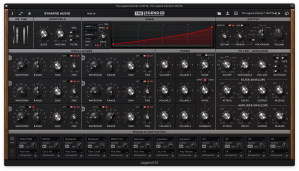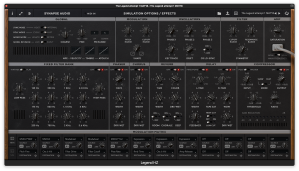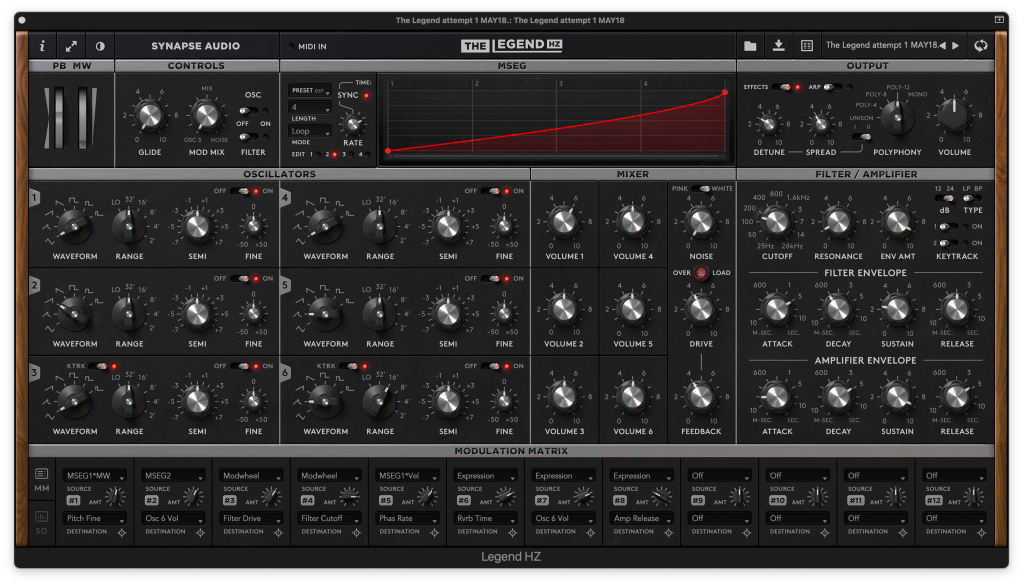Synapse Audio’s The Legend HZ accurately simulates the circuits of Minimoog Early and Late models. It has an 8x oversampled engine, a vectorised core (Unison, Mono, and four voice Polyphony modes), six oscillators, Hans Zimmer’s personal Vintage 914 Fixed Filterbank, and 213 patches made in cooperation with Zimmer in addition to the 440 presets from the previous The Legend plugin.
The Legend is recognised by many to be one of the best Minimoog emulations on the market. The Legend HZ, however, is in a class of its own. For example, of its six oscillators two can be used as LFOs with additional polyphony settings to match, it has an extensive modulation matrix, a 32-step sequencer, four MSEGs, and an expanded effects section.
For this review I first listened to a number of YouTube videos by Minimoog owners demonstrating what they can do with the machine. I compared The Legend HZ with these and with the other emulation plugin I own, and I found that I could make The Legend sound very close to the hardware. But if you want to go beyond the limits of the machine and still generate the typical Minimoog sound, e.g. for diving deeper into the realm of cinematic sound design, you’ll find the plugin doesn’t have a problem with that at all. It will effortlessly take you into the realm of sounds like the ones Vangelis created for Blade Runner on an entirely different synth than the ones we hear in “They shoot horses, don’t they?”.
Experience
When initialising The Legend, the first thing I heard was — as I had with Synapse Audio’s flagship synth DUNE 3.6 — this ultra-clean, ultra-neutral sound from which you start creating your own patches. The eye, on the other hand, sees an impeccable, beautiful interface. To accommodate all the features, The Legend uses a front and back panel with several ways to switch between them, so it won’t interrupt your creative flow.

The Legend HZ’s UI does not try to mimic the analogue Minimoog one-on-one and I personally like that a lot as the plugin follows a workflow that is familiar to digital synthesiser users with oscillators, noise generator, amplifier and filter envelope, as well as Mixer, pitch bend and modwheel knobs, Controls section, and Output section on the front panel. Everything else, including the Fixed Filterbank with its Flat and Vintage switch, and the effects section are situated on the back panel of the plugin.
The controls are all simulating analogue knobs, clearly laid out, beautifully designed and accompanied by analogue looking switches. The whole interface gives excellent visual feedback and makes spending time with the plugin an almost guilty pleasure.
Of course I had to go through all of the patches Kevin Schroeder created in cooperation with Hans Zimmer. It came as no surprise that most of them are perfect fits for recalling atmospheres and emotions beyond what you’d expect from presets that are suitable for purely music playing. If you close your eyes while playing the 217 new presets, you can vividly imagine scenes that fit them perfectly. This is even more obvious for the SFX category of patches which belong to the best of the best.

Creating patches yourself with The Legend HZ is as easy or difficult as it would be with any Minimoog emulation that has expanded functionality. The basics are dictated by the analogue version, with the expansions adding a level of complexity in sound, but in this case not necessarily in user experience.
Put another way, if you know DUNE, you’ll be instantly familiar with The Legend HZ. If you know any other of the top ten digital synths on the market, you may need to familiarise yourself with Synapse Audio’s take on how a plugin synth should be laid out — which would take less than a couple of minutes.
Results
If you want to have the Minimoog signature sound going beyond the strictest emulation but still clearly sounding like it, then The Legend HZ is the best there is. It emulates the machine as accurately as is technically possible, but additions like the three oscillators and the Fixed Filterbank expand the sonic range into even warmer, fatter and/or more aggressive results.
I quickly created a patch of my own, which in my most humble opinion does a fair job of showing off the fat face of Synapse Audio’s Minimoog emulation. Of course, the best way to judge for yourself is to visit Synapse Audio’s website and go through all of the patches.
The Legend HZ is available now for $179. Existing customers of the Legend synth can upgrade for $79.








Leave a comment